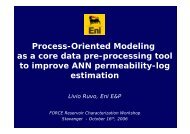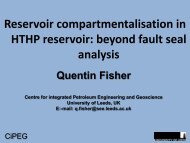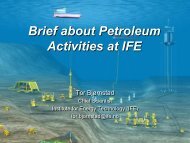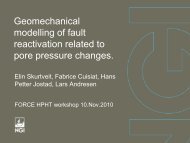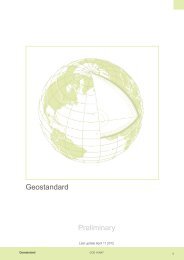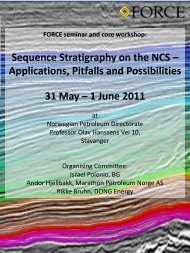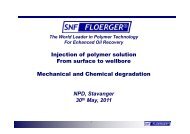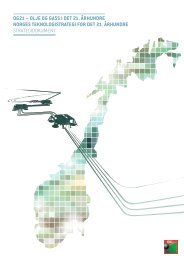Abstracts for FORCE seminar
Abstracts for FORCE seminar
Abstracts for FORCE seminar
You also want an ePaper? Increase the reach of your titles
YUMPU automatically turns print PDFs into web optimized ePapers that Google loves.
<strong>Abstracts</strong> <strong>for</strong> <strong>FORCE</strong> <strong>seminar</strong><br />
” Jurassic and Lower Cretaceous Sedimentary Systems of the Utsira High”<br />
19.-20.06.12<br />
Integrated geological studies as a key to understanding the geology<br />
of the Johan Sverdrup discovery – with examples from the PL 501<br />
area<br />
Ronald Sørlie 1 , Erik Hammer 1 , Michael Charnock 1 , Hans Amundsen 2 and Lars<br />
Riber 3<br />
1 Lundin Norway AS, Strandveien 50D, NO-1366 Lysaker, Norway<br />
2 Vestfonna Geophysical<br />
3 Department of Geosciences, University of Oslo<br />
Contact email: Ronald.sorlie@lundin-norway.no<br />
Abstract<br />
The Johan Sverdrup discovery was made in August 2010 in well 16/2-6, PL 501. The discovery is<br />
defined as a fault-bounded trap against the Southern Utsira Basement High and overlying Jurassic<br />
shales and/or Cretaceous Åsgard marls. The main reservoirs consist of a sequence of Middle and<br />
Upper Jurassic sandstones of excellent quality. Appraisal wells drilled during 2011 and 2012 in PL501<br />
(16/3-4, 16/3-4A, 16/2-7, 16/2-7A, 16/2-11 and 16/2-11A) and PL265 (16/2-8 and 16/2-10) have<br />
confirmed the extension of the Johan Sverdrup discovery.<br />
Several studies and analyses have been per<strong>for</strong>med, including petrography, sedimentary studies,<br />
isotopic analyses, biostratigraphy and field analogue studies among others.<br />
The Draupne sandstone of Volgian age consists of unconsolidated very coarse to medium grained<br />
sands, with very few sedimentary structures. The sandstones appear massive and are thought to<br />
represent an amalgamated marine, high density gravity flow/bedload deposits. The Middle Jurassic<br />
Vestland Group sequence is dominated by channel deposits in a non-marine setting.<br />
In addition to the biostratigraphic analyses, significant variations in the mineralogical content are<br />
observed and used when defining the different reservoir zones.<br />
The petrophysical properties of the Jurassic age reservoirs are excellent with porosities in the upper 20<br />
to 30%-range and multi-Darcy permeability. Outstanding flow characteristics are confirmed from well<br />
tests (DST) in wells 16/2-6, 16/2-11 and 16/3-4.<br />
Quantitative biostratigraphy has been undertaken on the extensively cored reservoir section. The<br />
primary tools <strong>for</strong> stratigraphic calibration are dinocysts (marine microplankton), spores and pollen.<br />
Other microfossils (Foraminifera) and macrofossils (Belemnites) have been used to determine the<br />
palaeoenvironmental settings of the reservoir sediments, particularly the presence of marine conditions<br />
is indicated in both the Draupne shale and Draupne sandstone reservoir unit.
Johan Sverdrup sandstone reservoir sedimentological pattern and<br />
evolution: an integrated depositional model<br />
Mario Vigorito, STATOIL ASA<br />
Following the discovery of the Johan Sverdrup giant oil field, a total of 11 exploration and<br />
appraisal wells have been drilled to delineate the discovery. Ten wells have acquired<br />
extensive core coverage of the reservoir section which mostly consists of medium to very<br />
coarse Jurassic sandstones. All the wells show similar lithological and sedimentological<br />
patterns which allow <strong>for</strong> good correlation across the field. On the basis of detailed<br />
sedimentological, petrographic, palaeontological, and wireline logs analyses, the reservoir is<br />
divided into four units whose relative distribution and volume vary across the field: A) fluvial<br />
coarse sandstone and overbank silty\muddy deposits; B) fluvial and locally fluvio\deltaic fine<br />
to coarse sandstone and silty-muddy overbank deposits, locally pedogenized; C) Tidally<br />
influenced estuarine to marine-tidal medium sandstone, and D) shelfal coarse to very coarse<br />
sandstone, mainly gravitative fan delta deposits locally reworked by bottom currents. Units C<br />
and D generally represent the bulk of the reservoir interval and display exceptionally good<br />
reservoir properties.
Henrik Olsen, Maersk Oil<br />
Reservoir heterogeneities in the Johan Sverdrup field – a sedimentological perspective<br />
The Jurassic reservoirs in the Johan Sverdrup field show variations both vertically/stratigraphically and<br />
laterally across the field. In this presentation Maersk Oil will demonstrate the variabilities of the<br />
reservoirs and the impact of different sedimentological interpretations on the possible heterogeneity<br />
distribution in the reservoirs.
Geological setting in the greater Draupne area with a focus on the Middle and Upper Jurassic<br />
succession<br />
By Evy Glørstad-Clark, Ingeborg Waldal Verstad, Lars Arnesen, Kai Hegglund, Anne Marit Næss, I<strong>for</strong> Roberts<br />
The Draupne Field and Hanz discoveries are located on the Gudrun terrace on the eastern flank of<br />
the South Viking Graben in blocks 16/1 and 25/8. The reservoirs range in age from Middle Jurassic in<br />
the Draupne field to Late Jurassic reservoirs in Hanz (25/8). Rift related faulting and associated<br />
localized tectonic subsidence occurred in the area, influencing sediment routing, gross thickness,<br />
facies distributions and facies belt orientation. Significant reworking of the sediments during this<br />
time period, and accommodation space was fault controlled from Callovian times. Significant paleotopography<br />
developed during Late Jurassic, resulting in localized sand distribution.
Remarkable variations in the Jurassic - Lower Cretaceous<br />
Sequence Stratigraphy of the Utsira High Complex with emphasis<br />
on the western margin of the Haugaland High and Gudrun Terrace.<br />
Michael Charnock, Erik Hammer and Ronald Sørlie<br />
Lundin Norway AS, Strandveien 50D, NO-1366 Lysaker, Norway<br />
Contact email: macharnock@lundin-norway.no<br />
Abstract<br />
The Utsira High has had a long history of exploration in the Norwegian Sector of the North Sea.<br />
Despite this history, recently drilled wells with excellent core coverage and integration with seismic<br />
have provided new insights into the complexity of depositional styles on both western and eastern<br />
sides of the Haugaland High (southern part of the Utsira High complex) during the Middle Jurassic to<br />
Lower Cretaceous interval. It is hoped that highlighting these variations will invigorate new<br />
interpretations and exploration activity of this ‘well-known’ petroleum area.<br />
A comparison is made between the western margin of the Haugaland High - Gudrun Terrace and the<br />
eastern side in the Haugaland High - Karmsund Graben - Avaldsnes High areas (Johan Sverdrup<br />
Field). It can be demonstrated that in addition to some commonality, there is also considerable<br />
variation between the timing and depositional fill of the two areas during this time period.<br />
Depositional styles (along strike) on the western margin of the Utsira High also show remarkable<br />
variation in both large-scale sequence stratigraphy and depositional style. Shoreline and shelf<br />
sequences defined by uncon<strong>for</strong>mity bounded packages (SB/TS) are variably preserved in mini-basins<br />
developed along this western margin. Examples are described from three dip sections showing that<br />
sedimentary packages are represented by transgression, progradation, aggradation, passive infill,<br />
sediment by-pass, hanging wall wedge deposition, and/or slumping-sliding depending on palaeolocation<br />
and in response to local variations in tectonic style and accommodation potential. These<br />
examples are linked to the viewing of the Apollo 16/1-14T2 and Tellus 16/1-15 cores in the following<br />
core workshop.
Outcrop analogues <strong>for</strong> the Jurassic discoveries of the Southern Utsira High. Case histories from<br />
Sardinia Oligo-Miocene rift system and Tertiary basins of Southern Italy<br />
Sergio G. Longhitano<br />
Department of Geological Sciences, University of Basilicata - V.le Ateneo lucano, 10 85100 Potenza, Italy. E-mail:<br />
sergio.longhitano@unibas.it<br />
The Oligo-Miocene Sardinia Rift Basin and other Tertiary basins of south Italy represent excellent<br />
outcrop analogues to the Jurassic deposits surrounding the southern Utsira High. In all study areas,<br />
sediments are dominated by conglomerate and sandstone, and sedimentary body geometries are<br />
also similar. These deposits are representative of continental to marine depositional systems which<br />
developed in tectonically-controlled confined (narrow-linear) basins. The outcrop analogues provide<br />
insight into reservoir architecture and heterogeneity in the Utsira High deposits at a subseismic scale.<br />
Through the use of classical facies analysis techniques on outcrop data, a better understanding of<br />
sediment distribution in extensional basins is achieved. The knowledge gained is demonstrated to be<br />
applicable to future exploration and development of reservoirs in the region.
EROSION OF PERSITENT BASEMENT “HIGHS” AND ASSOCIATED SEDIMENTATION<br />
FROM THE RONA RIDGE AREA, WEST OF SHETLAND<br />
Several present-day large structural features occur in the West Shetland Basin that <strong>for</strong>med<br />
persistent topographic (above sea-level) features <strong>for</strong> long periods during the Jurassic. The<br />
structural features comprise complex but poorly constrained assemblages of metamorphic<br />
Precambrian basement. Oil occurs in fractured basement and in Jurassic sedimentary strata<br />
that were derived from erosion of the basement. Precise stratigraphic data are sparse but it<br />
is believed that the coarse-clastic Rona Sandstone, which is the main siliciclastic reservoir<br />
target in the area, records intermittent sedimentation along the margins of degrading islands<br />
from (at least) the Middle Jurassic until the early Upper Jurassic after which the islands<br />
became completely submerged; eventually deep-water conditions prevailed. The<br />
combination of fractured and weathered basement, and the Rona Sandstone <strong>for</strong>m reservoirs<br />
in sub- and supra-uncon<strong>for</strong>mity stratigraphic traps that are overlain predominantly by finegrained<br />
Cretaceous strata and locally by Upper Jurassic (Kimmeridge Clay/Draupner<br />
Formation) mudstones intercalated with turbiditic sandstones.<br />
Andrew Hurst<br />
University Aberdeen



